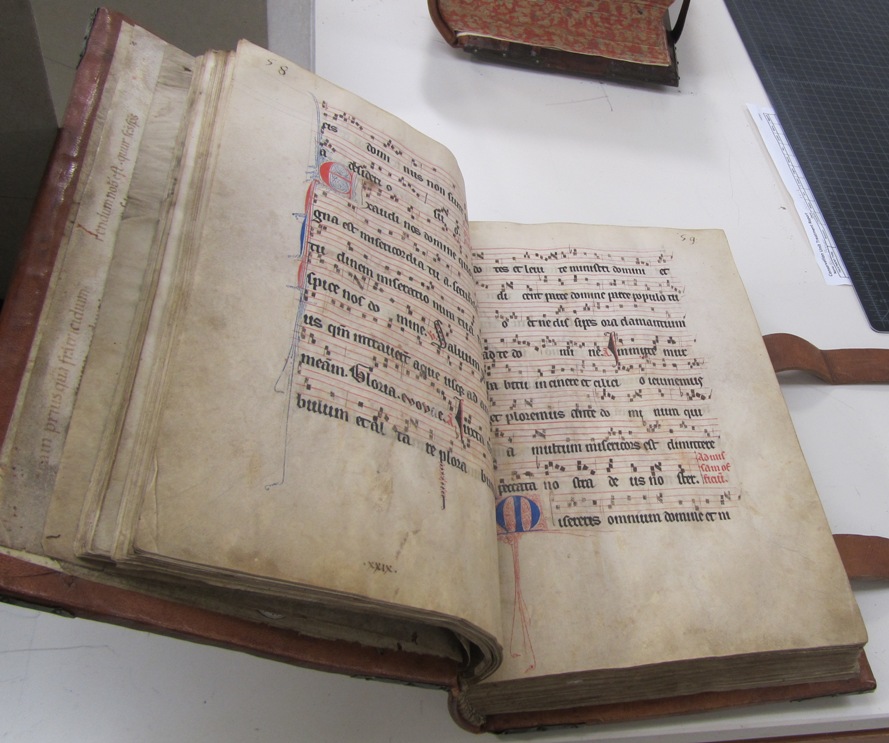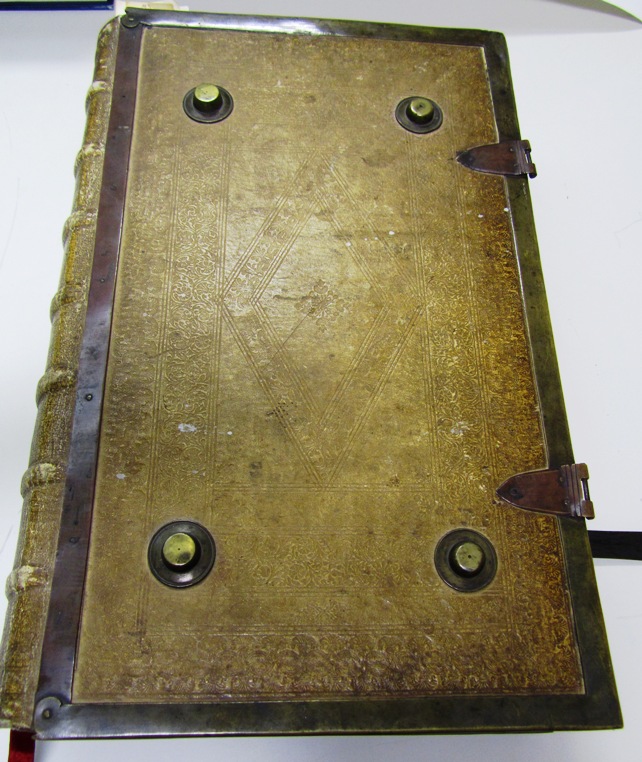Boxes and Bosses
Summer Conservation Intern Cheyenne Bsaies reports on how to house huge, metal-clad volumes.
I want to talk to you about boxes. It’s a deceptively simple topic, truly. But the boxes I’m talking about are a far cry from the corrugated boxes every college student knows from moving apartments every summer. For one thing, the boxes I’ve been making are destined to house some of the rarer items in the Spencer collections. They’re studier than a corrugated box, they open differently and they’re cloth covered. In short, they’re very fancy boxes for very interesting and unusual tomes.
If you’ve never had the pleasure of seeing and/or handling a very old book, I highly recommend that you visit the Spencer Library and speak to a librarian there in order to avail yourself of their resources. Maybe the only old books you’ve seen have been in the movies when the protagonist uncovers a secret in an ancient library. They’re huge, leather beasts covered with metal studs and straps and clasps, and you just know something important is going to happen when the hero opens one of them.
Left: Steinhardt Gradual. France, after 1253, (Call No.: MS J4:2); Right: Antiphonary,
Germany, 15–, (Call No.: MS J4:1). Click images to enlarge (trust us, they’re worth enlarging).
Well, those are exactly the books I had the pleasure of working with on this project! And, I have to admit, it’s hard not to feel a bit like Indiana Jones when turning their pages. First I’ll introduce each of them, talk about some of their special features, and then I’ll describe the box making process.
Antiphonary. Germany, 15– (Call No.: MS J4:1): A book of choral music for the Daily Office (or the liturgy of the hours, including matins and vespers), bound in light golden brown pigskin secured with brass bosses (the technical term for the metal bits on the covers). Interestingly, the leather visible on the book actually obscures the original leather covering which still lies beneath it. The bosses form a border around the edges of the covers, and only one clasp remains. The pages are vellum.
Steinhardt Gradual. France, after 1253 (Call No.: MS J4:2): A liturgical service-book containing Gregorian chant for the Mass, bound in leaf-brown calf with brass bosses on the corners and at the center. Long matching leather straps attach to two of the center bosses and keep the book closed.
Clamshell boxes for a German Antiphonary (MS J4:1) and the Steinhardt Gradual (MS J4:2)
Altoviti Family Records. Florence?, 1769-1791 (Call No.: MS J12:1): This is an old ledger bound in two-toned calf with brass bosses and leather straps. There are brass clasps attached to the ends of the straps that secure to the rear cover. Unlike the others, the pages of this book are paper, not vellum.
Antiphonary. Spain?, 15– (Call No.: MS J5:1): Another choral book hand lettered on vellum, bound in dark brown calf. This volume sports the most ornate style of bosses, and even the brass nails are tacked in decorative rows.
Clamshell boxes for Altoviti Family Records (MS J12:1) and a second Antiphonary (MS J5:1)
Due to the size of these books and the amount of metal on their covers, they present a risk to their neighbors on the shelf and can be a challenge to move. Also, large, heavy books such as these should be stored lying flat. Therefore, one of my tasks as an intern has been to provide a stable, sturdy and comfy home for these special books. The style of box construction used for this project is called a clamshell because…well, it opens kinda like a clamshell! The design allows the box to open flat, making it easy to remove and replace the contents, and the walls of the bottom half nest into the walls of the top half providing extra support to the structure.
Newly constructed clamshell boxes and their precious contents (click images to enlarge).
They’re made of a thick composite board, cloth, paper, foam and LOTS of glue. In order to accommodate the weight and metal furnishings, I cut out custom foam inserts for each of the books which I then covered in a matching cloth. I also lined the “roof” of the box with a thin layer of foam to prevent damage from potential impact. Each step presents its own challenges, and half of the time is spent waiting for parts to dry. I think you’ll find the results are, however, undeniably awesome.
Unfortunately, this will be my first and only post for the Spencer Research Library blog. My internship ends this week. However, I have had more fun here than on any other assignment or with any other team of people. A lot of it has to do with the amazing folks in the Stannard Conservation Lab, and the rest I attribute to the homey and chill atmosphere of this campus and this town. I leave Kansas knowing that I’ve may have helped extend the life of some lovely old books, and I’ve made friendships certain to last.
Cheyenne Bsaies
Conservation Summer Intern
[Editor’s note: We’ll miss you too, Cheyenne! Thank you for your immensely impressive work.]
Tags: Altoviti Family Records, Antiphonaries, Cheyenne Bsaies, Clamshell boxes, conservation treatments, Graduals, Metal Bosses, protective enclosures








